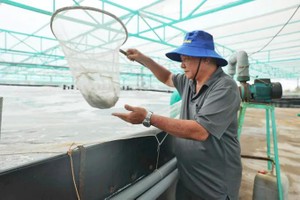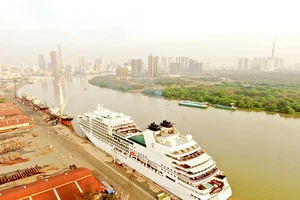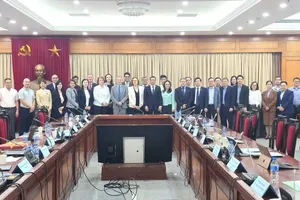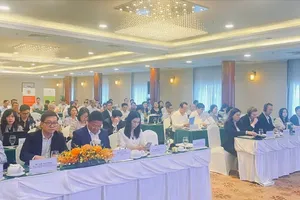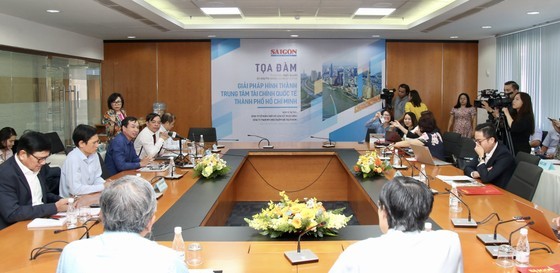 |
| At the yesterday seminar ( Photo: SGGP) |
SGGP Newspaper yesterday held a seminar on forming the International Financial Center in Ho Chi Minh City with the participation of many experts from economics, businesses, banks, financial institutions and the environment.
Speaking at the seminar, Mr. Nguyen Ngoc Hoa, Chairman of the Members' Council of the Ho Chi Minh City Finance and Investment State-owned Company, said that in the Politburo’s Resolution 31-NQ/TW issued on December 30, 2022, on the direction and tasks of Ho Chi Minh City development to 2030, with a vision to 2045, many breakthrough solutions and strategies including promulgating policies to promote the formation and development of the International Financial Center in the southern metropolis have been proposed.
Up to now, the project contents of the International Financial Center have basically been completed while waiting for city leaders’ approval and it will be submitted to the central government for consideration. Accordingly, three core pillars of the project namely the money market and the banking system, capital market and derivatives market should be completed.
 |
Ho Chi Minh City plans to set up an international financial center in Thu Thiem New Urban Area in Thu Duc City |
According to Mr. Nguyen Ngoc Hoa, the city has received two waves of investment. In the first wave, the southern largest city succeeded in attracting many enterprises in many fields and formed many EPZs and IZs.
In the second wave of investment, the city has been more selective, in the direction of improving the quality of enterprise capital flows. Typically, it was successful in constructing a high-tech park, attracting many high-tech foreign-invested enterprises to produce high-tech products such as Samsung, Intel, and Nidec Sankyo.
These leading manufacturers have created the basis for moving global supply chains to Vietnam. However, in the current context, the scale of the economy increases, and the capital needs of enterprises and organizations to expand the scale of investment and development also increase. Meanwhile, the banking system only provides limited capital which just meets the needs of small and short-term loans whereas commercial banks can’t meet the capital demand of large-scale investment projects, which create resilience for the economy such as investment in superports, sustainable development, transport infrastructure, logistics.
This forced Ho Chi Minh City to create the third wave of investment attraction by forming the capital market from the HCMC international financial center.
With the same opinion, a representative of Ho Chi Minh City Urban Environment Company said that to invest in a waste incineration plant with a capacity of over 1,000 tons of waste per day, it needs about VND3,000 billion (US$127,238,141), depending on the technology used. Additionally, the representative wondered how much capital the company needs for a waste treatment plant with the capacity of about 10,000 tons of waste per day.
Similarly, Mr. Tran Ngoc Thach, Deputy General Director of Saigon Port Company, said that the company is making a pre-feasibility study report of Vietnam's largest port in HCMC’s Can Gio outlying district with a throughput capacity of 10-15 million TEUs per year. The international port’s investment is estimated at about US$5 billion. The project needs a 15-17 year loan. Hence, the early establishment of an international financial center will be the foundation to attract financial institutions, investors and financial groups to create a strong push for industries to develop together.
To add more information about Ho Chi Minh City International Financial Center, Mr. Nguyen Ngoc Hoa informed the availability of the monetary market and banking system.
According to him, the capital market is only in its infancy, forming in the form of bonds in certain fields, mainly the real estate industry. There has been nothing for the derivatives market, even the most elementary commodity electronic trading floor has not yet formed. Therefore, in the coming time, the government necessarily builds a synchronous and inclusive legal and institutional framework for all fields in which foreign investors poured money in. This legal corridor must approach other financial centers already in the region and in the world. Next, it is necessary to choose the core competitiveness for this financial market, accompanied by a specific legal mechanism to attract investors to participate in the market. Finally, it is necessary to have a synchronous infrastructure investment policy to create a favorable working, living and entertaining environment so that investors, financial experts and their family members can enjoy it.
Meanwhile, being an economic expert's perspective, the HCMC University of Economics’ lecturer Huynh Thanh Dien affirmed that the legal corridor must create favorable conditions for investors to participate in the market. The business environment in Vietnam must create many profitable opportunities for investors, such as diversifying the startup and innovative ecosystem. Besides, the legal framework must help potential enterprises to expand production and business scale, expand domestic and export market share as well as invest in infrastructure construction. Last but not least, the government must make investors trust the country’s legal system with its transparent information and teams of professional consultants.






